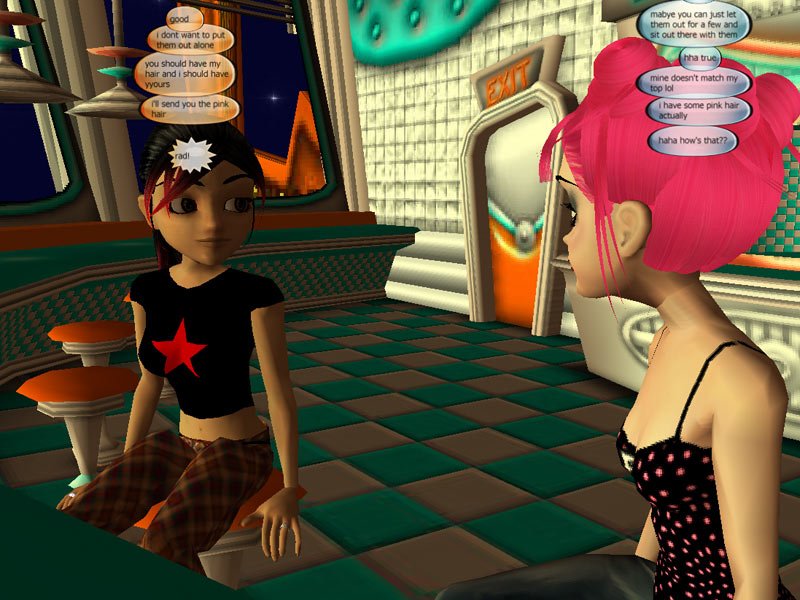IMVU: A brief history
Reading Level: Advanced/College Student
Reading Time: 15 minutes
Have you ever wondered how IMVU used to be over 10 years ago? 15 years ago? We’ll dive deep into it! 😀
I joined IMVU in 2006 and everything back then was much different! From the way the client looked, how shopping was done and even what kind of upgrades you could buy for your avatar. If you’re curious to know how IMVU used to be back in my time, keep on reading (or just look at the pictures :D).
Note: The following article is written from my own experience. I had many memories of old stuff and I tried researching to provide images that could accurately describe what it used to look like back in 2006 and the following years.
IMVU client
The IMVU client was a simple program much like other messenger application from around that time (MSN, Yahoo messenger).

The messenger itself had two categories like in the picture above, one for “buddies” and one for “inventory”. It’s very strange compared to what we have today, but back then, there weren’t many items in the shop and people would keep small friends list.

The chat was a separate window like in the picture above and lo and behold, the IMVU cafeteria is a classic room, but back in the day, it was both really awesome and very boring due to the lack of rooms on IMVU.
The inventory was not yet integrated into the chat window.
One important difference was that the IMVU version of 2006 had an inventory section for “UI Skins”. This was an awesome feature because it allowed you to customize the skin of IMVU.
I remember back in the day wanting to decorate my UI with Christmas-themed UI skins.

Today, that category no longer exists and the parent ID from which items were derived has been hidden, as well as derivations. Luckily, my memory is still very good and while I could not find actual screenshots of modified UI using the custom skins, I did find the original product ID, as well as one holiday-themed skin made by pinkpheonix (pinkphoenix today). I used to fangirl over that UI skin a lot because it was well made and I couldn’t afford it. 🙁

This UI skin product I believe was quite similar to the dummy bundle, in the sense that you would derive from a base product that did not actually exist (I think).
Here is a derivation of this product: Christmas-themed UI skin
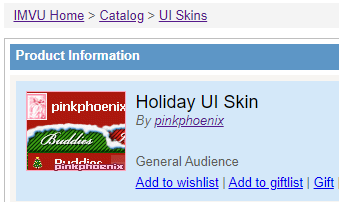
Funny enough, the category for UI skins exists to this day, but the products were removed from the category, meaning there’s no direct way of browsing through these types of products.
I wasn’t around for long to enjoy custom UI skins and after the winter of 2006, the skins were completely removed from the catalog and the items removed from the inventory of users because IMVU had a UI upgrade. Although these products were disabled/could no longer be used, IMVU never issued any refunds for this particular matter.
Chatting
Chatting was a separate window from the Inventory/Buddy list and it had several quick buttons on the bottom right of the screen. I personally was a fan of the cascade windows. It was easier to see which window was being active (as Windows would notify the user by coloring the application tab in orange).
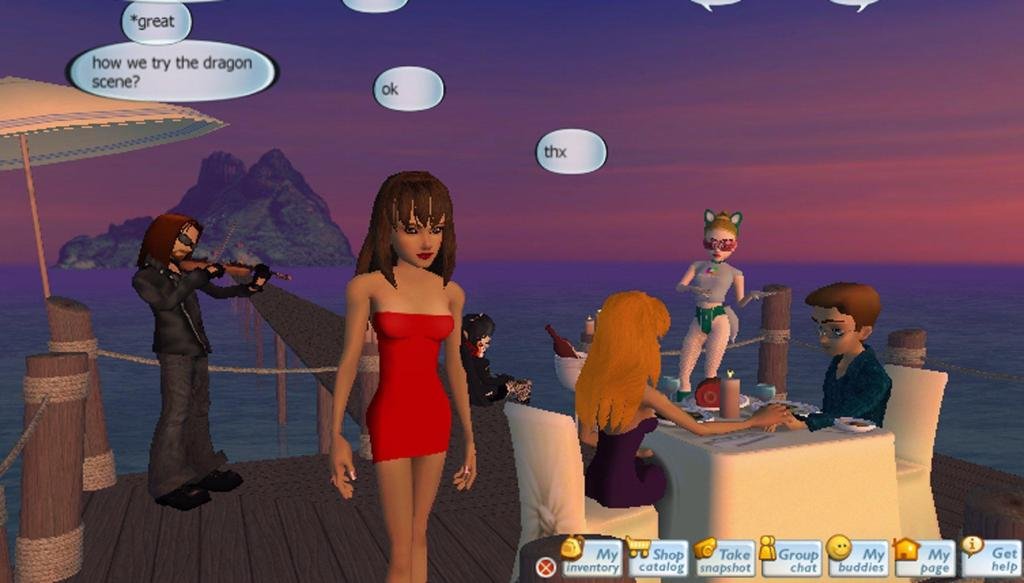
Back then, all chat bubbles were the same color and there was no option to see the chat displayed as simple text as we do right now. You only had bubbles. Wanted to re-read something? You better dragged those bubbles fast, otherwise, if the other person created more text bubbles, you’d lose the history fast!
[dt_divider style=”thin” /]
The Previewer
Back in the day, if you wanted to create on IMVU, you had to download a separate application called Previewer. Much like the creating process today, it featured various options to create, edit products, meshes, animations etc.
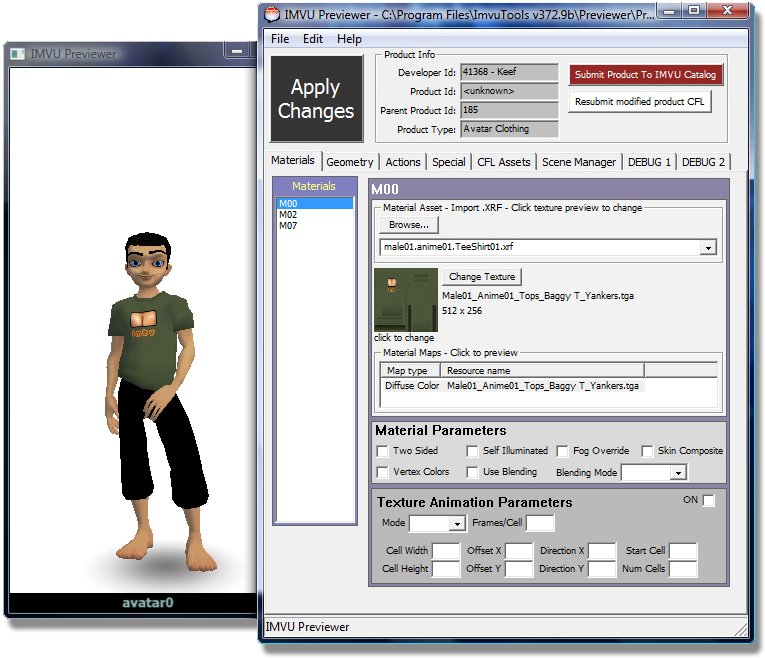

Creators were used to be called developers. The term was popular for many years, but IMVU decided to switch to naming the users that were making content “creators” which was a better fit since the term developer was more associated with software developers and the technical people that write code.
Pro developers
Being a pro developer was a serious matter. Pro developers had to fill in an application form that was reviewed by IMVU after careful consideration. There was some serious criteria too, not everyone could apply to be a pro creator. I don’t remember much, but I do remember some of the insane requirements:
- Earn ~ 7,000,000 credits monthly or have tens of thousands of sales
- Outstanding catalog – you had to have the items correctly rated, as well as adding product descriptions and images to the items added to the catalog
- Had to be an experienced mesher that could make unique creations
- Had to have a few pages in the catalog to showcase your work
Now, you might be wondering why being pro was so hard to achieve and so selective. The answer is interesting:
There were no tier levels, there were the excellent creators and everyone else.
Pro developer perks
- Pro developers had a unique tag next to their names in the catalog
- Pro developers had product priority in the category of the shop, meaning that their items were showing first before any other creator’s
- Pro developers could create product categories in the shop
The chaotic names and abundance of categories on clothing are a result of pro developers create those categories.
- Pro developers used to have a close relationship with staff, as they were very, very few and would often create custom content, bundles, etc. for various events
Other perks that came with being a pro developer:
- Everyone admired pro developers. Because this was such a hard thing to obtain and only a select few would meet all the criteria, users browsing the shop would admire pro developers a lot, to the point of worshipping them. Users would message pro developers to show their genuine admiration, begging for gifts was not yet that common. Nowadays the same thing happens to a much lesser degree, mainly because being pro or being a known creator is no big deal, since there are thousands of amazing creators.
- IMVU did not pay developers directly, instead, people would sell credits directly to users. Big websites with a great reputation would only work with pro creators.
- Because they were being featured on the first pages with priority over others, they would make a lot of sales, however, products in the past were cheaper. It was very common to see products under 399 credits and the developers would still earn credits. This was also because IMVU fees in the derivation chain were lower.
Interesting fact: IMVU increased the prices on the IMVU markup fee for every single product 2 times. That means that every single item in the catalog went through a price increase 2 times because of IMVU’s increased fee.
The catalog
The shop was called the catalog. This is because when you would go to buy something, you could only do so with the browser and you were greeted by a long page full of categories that were accompanied by images.
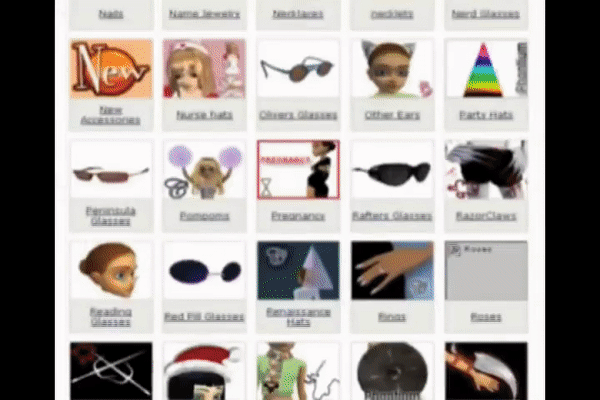
Sales were exclusively done through the browser.
Because some features as “try on” were unavailable, catalog description and images of the products were a must.
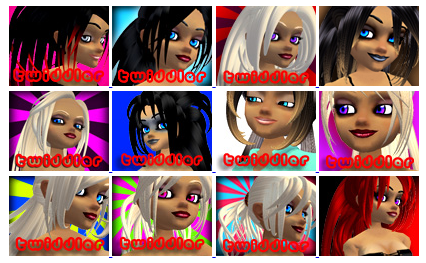
The catalog description has not changed at all compared to what we have today, but back then, you would always see at least something in the description box. This is why in Peer Review you could fail a product if it had a missing description. Although that should be deprecated now, it started like that.
Peer Review came to life a few years after 2006.
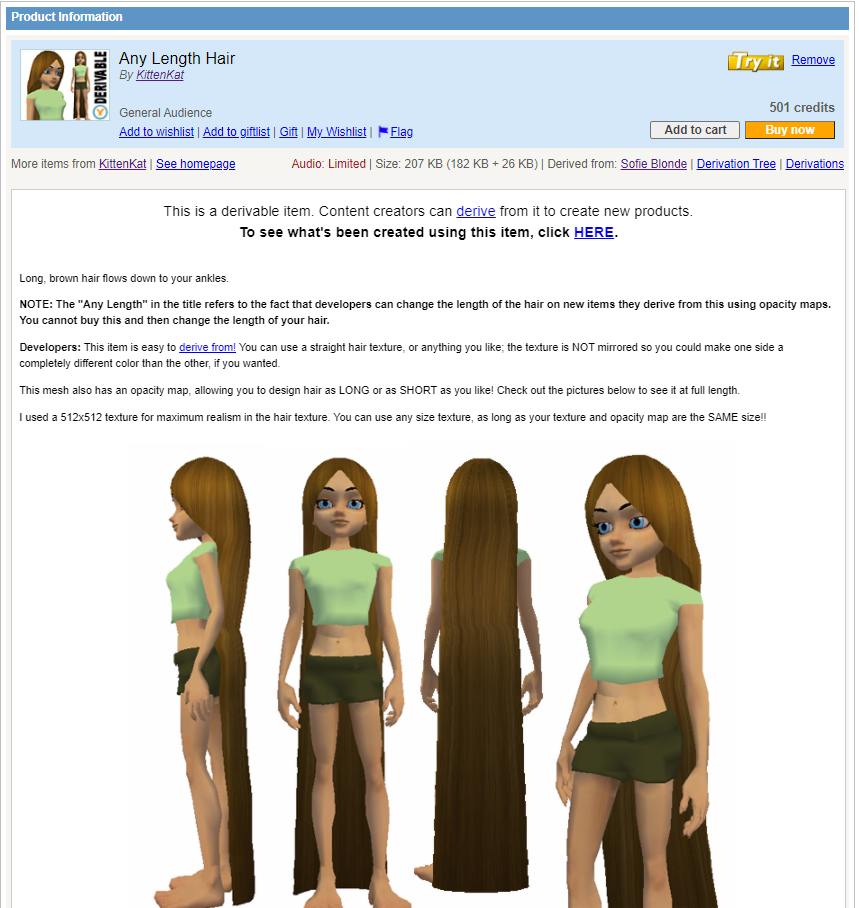
shop: it was browser only and you had to browse through categories, each category had a display image
sales were exclusively done through the browser
Bundles
Bundles were considered luxury. Many times, developers would create bundles with exclusive content which was only available with bundle purchases and could not be purchased separately.






Reviews
Reviews on items were very common. As people would check the catalog all the time to buy things and would pay attention to the description of the item purchased, many people would return to write a review on the product purchased.
Back then, you could have 200 sales on an item and 20 reviews, and today you can have 200,000 sales on an item and 2 reviews (if any).

The most popular product ever reviewed (organically) is a skintone by Irresistible. It has over 1100 reviews and it comes from the era when people started changing their names to premium names, as well as a great era for the popularity of skins in general.
Developer earnings
There were credits and promo credits. Developers would earn the credit profit set for the items sold and the equivalent sum in promo credits.
Dev tokens did not exist. Dev tokens got their name from developer tokens.
IMVU did not pay developers directly, instead, developers would either associate themselves with IMVU-user-managed businesses that sold IMVU credits directly to users or could try doing so themselves.
Because of this, there was no limit to how many credits one could send or receive in a day/week/month!
Promo credits always came first
If you owned a positive balance for both credits and promo credits, when you would buy an item from the catalog, you would always consume your promo credits first. Whereas today, you will first go through the available balance you have for credits and only when that balance is 0, will IMVU start taking from the promo credits balance.
Developer banners on product pages
I am not sure whether this started as a perk for pro developers, but I do know that these types of banners could still be requested after the manual pro developer system died.
You could create a custom banner that would be showcased just below the buy button. The same banner appears on derivations from such products and some are still in place today.
Homepages
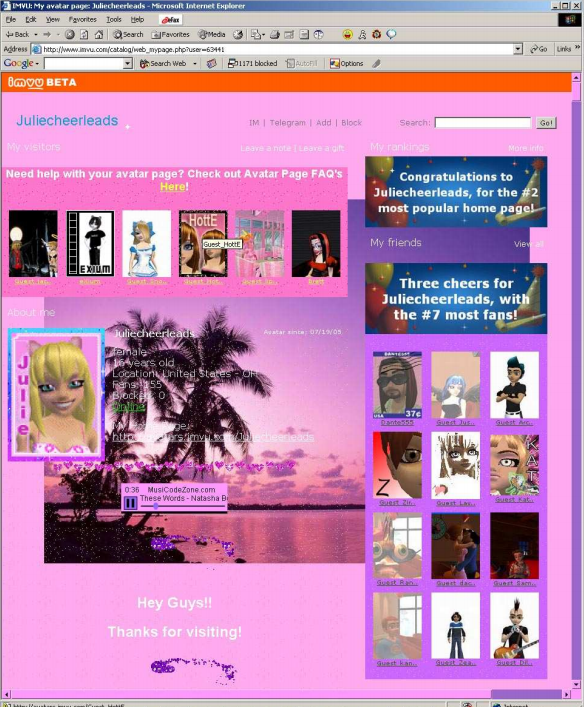 Homepages were HUGE! Because every user would have to buy going to the browser catalog, homepage activity was huge! People would design their homepages with HTML/CSS, add noticeable backgrounds, express their creativity through stickers (you could earn thousands of dollars a month just through stickers back then).
Homepages were HUGE! Because every user would have to buy going to the browser catalog, homepage activity was huge! People would design their homepages with HTML/CSS, add noticeable backgrounds, express their creativity through stickers (you could earn thousands of dollars a month just through stickers back then).
Because homepages were so popular, users would showcase their support for their favorite developers through banners. That’s right, a small image that had a direct link to a developer’s catalog. They were highly efficient too! This was until more and more people started creating their banners and naturally, as the IMVU community grew, so did the developer/creator community and gradually people lost interest both in supporting developers through banners and in checking those banner ads.
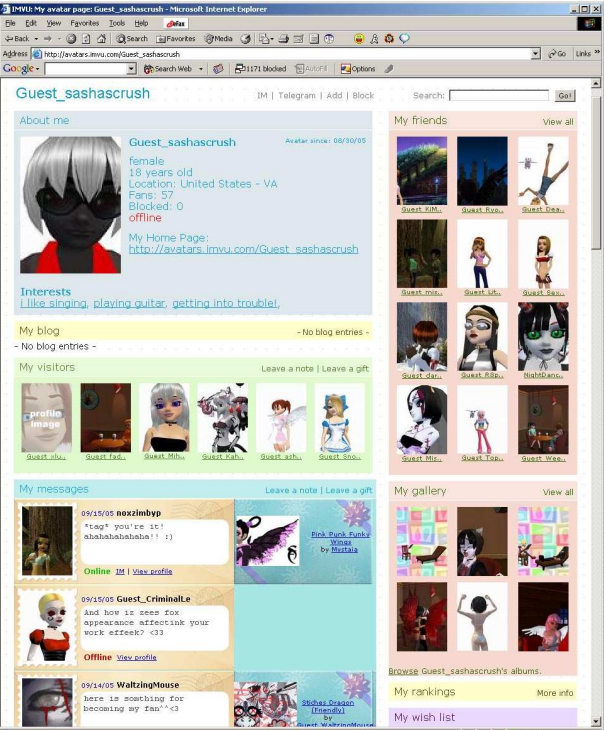
The way people would design their homepages in general was code-wise simple, but the style to pimp up the homepage with glittery images and stickers was very common, borrowed from old, popular websites such as myspace.com, piczo.com, bimbodoll.com, etc.
Both females and males would do some type of personalization to their homepages, because the inbox was… public! That’s right, the whole was public for everyone to see. I do remember a private option, but private messages through inbox were extremely rare. People would visit your page, would look at your messages and everything posted on the homepage. It was really fun, not very private, but it was fun! 😀 You had a good feeling when you left someone a gift because everyone could see it. Maybe they’ll bring this part back for bragging rights? Who knows, but I like my privacy with my inbox right now. I do miss reading up drama from time to time, though.
It was also common to have various tabs that encouraged socialization, such as “Online now”, “Meet new people”. Those tabs would have a handful of users and their avatar showing on your homepage.
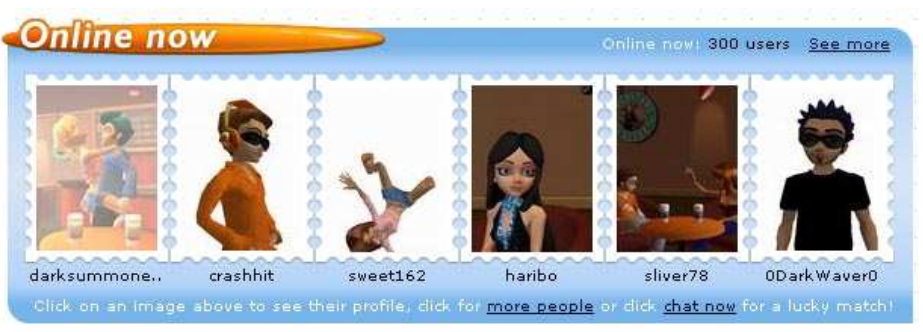
It was quite cool to click on them and invite them for a chat, then have them accept your invitation and not know what to talk to them about. Or, was it just me? Oops.
Inviting people
It was very common for people to invite friends because they would get a looot of credits. A lot! You would get promo credits, but you could earn tens of thousands of promo credits, easily going over 100,000 credits, depending on how much the person invited spent on IMVU. You would earn credits every time they bought an upgrade such as registering their name (removing Guest_) and when they became a creator.
IMVU Upgrades
Much like today, users would register as guests, meaning their username would have a “Guest_” in front of their name.
The most common upgrade was buying your name, aka registering your name. Some of the upgrades still exist today, while others were deprecated.
It was very common to have really good deals on upgrade bundles where you could get credits and other cool stuff.
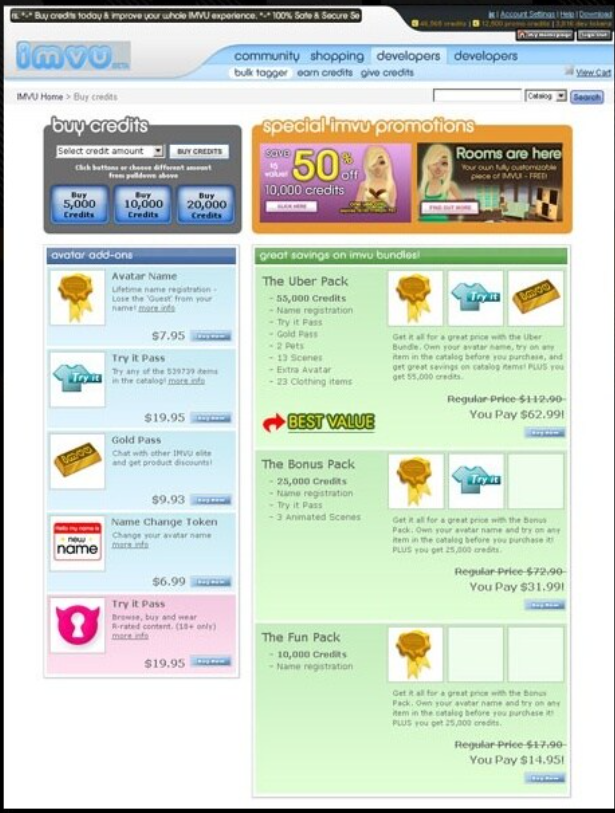
Avatar Name
This used to be 7$ when I first joined. Buying the avatar name would remove the “Guest_” from your name and allow you to create. That’s right. Back then, creating was a one-time fee of 7$. That’s how much grandfathered accounts paid to be able to create even today. If you don’t know what grandfathered accounts are, you can find out more information here.
Access Pass
Allowed IMVU users to try on and buy R-rated items. Basically 18+ content. The same product is available today.
Try It Pass
I love this one because it sounds insane today, but back in 2006 there was no option to try on clothes before buying them. Instead, you could buy the Try-It pass which was 18$ that allowed you to – you guessed it right – try on clothes before buying them!
I can honestly say I am happy they implemented the try-on feature for everyone, but I’m not as happy to share with you the fact that when IMVU implemented this, no refunds were given (to the best of my knowledge) to any user who purchased this upgrade in the past.
The Try-It Pass no longer exists in the IMVU shop.
Gold Pass
Gold pass was the first attempt IMVU made at implementing a sort of loyalty-discount to customers. Besides this, there was some sort of socialite status that came with it.
 Gold pass layered the foundation to the VIP program of today and while it is no longer available for sale in the IMVU upgrade shop, users that have purchased this upgrade still benefit from it today and it shows up in the account settings. The only benefit today is the VIP-equivalent discount for all the product items in the catalog, without fancy badges and other benefits that are exclusive to the VIP program.
Gold pass layered the foundation to the VIP program of today and while it is no longer available for sale in the IMVU upgrade shop, users that have purchased this upgrade still benefit from it today and it shows up in the account settings. The only benefit today is the VIP-equivalent discount for all the product items in the catalog, without fancy badges and other benefits that are exclusive to the VIP program.
The Gold Pass no longer exists in the IMVU shop.
Name Change Token
This did not actually exist back when I joined IMVU in 2006. This might have been added for two reasons: for users who wanted to change their usernames and to deactivate old accounts and recycle names.
When this was added, premium names became huge on IMVU and many creators opted for short, luxury/everyday sounding names.
These were the upgrades IMVU offered back in the day. Once IMVU introduced the fancy badges that you could display along with your avatar name, they also introduced a bunch of other upgrades to get cool badges, or they made some upgrades be dependent on other upgrades (for example, today, if you want to change your name, you must first own your avatar name, then purchase as name change token; having VIP does not exclude you from this).
Shoutouts
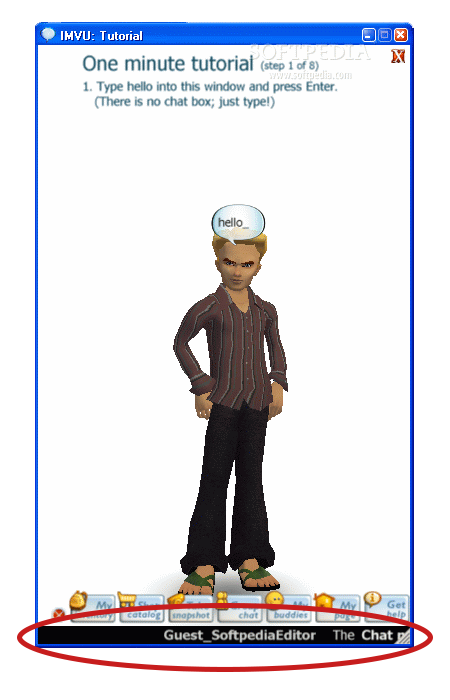
Shoutouts would appear in the browser and in chats. Unlike today, the shoutout bar back in the day was huge! It was 3 or 4 times longer than what it is today, add the fact that they were visible at the bottom of the chats whenever the chat was open and you have a great recipe for success.
They were very efficient in promoting your business.
I can’t remember how much they cost. There were no dev tokens back in 2006 yet, but shoutouts were very expensive for the average creator. The upside to this was that when you could afford one, it would be both visible and showcased many times, thus making it highly efficient.
As IMVU’s userbase grew and more UI changes were added, more and more people were buying them and you could only see them in the browser version.
Not only this, but making the bar for shoutouts smaller contributed to making shoutouts not as efficient in terms of attracting customers to your shop or homepage. This was somewhat expected as IMVU grew because it started using more space for its own banners to advertise upgrades, deals, bundles, etc.
The forum
Today we have the discussions sections where we interact with other people, read IMVU announcements or decisions, interact with staff, ask for product requests, showcase our art, but back then, there wasn’t such a thing. Instead, there was a forum much like every other forum website at that time. It had the classic design of a forum and they were quite popular, especially for art lovers and people who wanted to socialize and stay updated with the latest trends around the world.
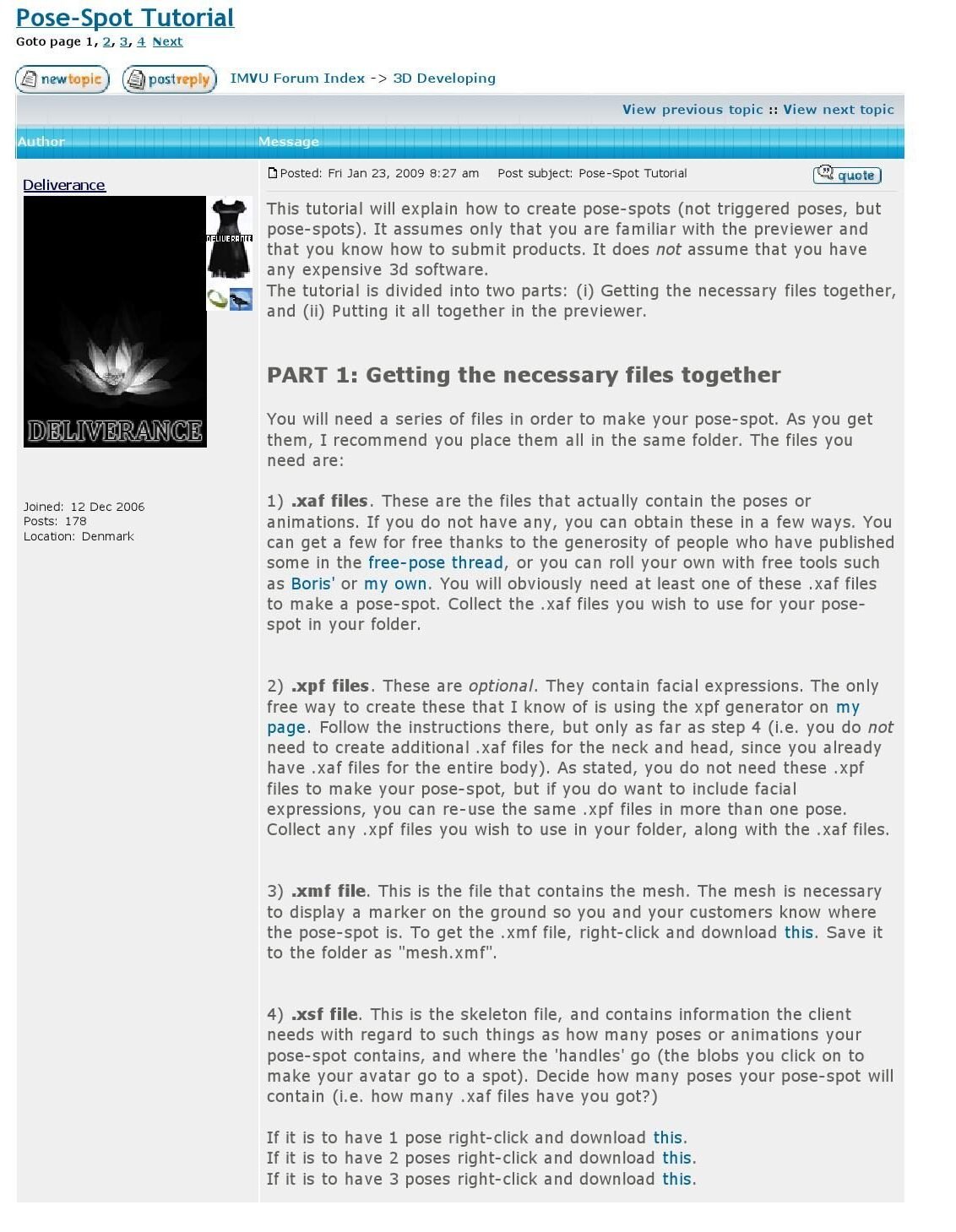
Avatar moods
We are able to showcase our creativity in many ways today. One of them is choosing a suitable avatar for the pose or event we’re participating at. Back then, poses were uncommon, let alone still avatars.
Instead, it was very common for people to select moods.
Moods are a series of slight avatar movements/animations bundled up with a facial expression to imitate in a very cartoonish style human emotions. You would have anger, flirty, scared and many others. This equipped with the default animations you could do to another avatar were the only poses for a while we could enjoy.
Moods still exist today and you can equip them by right-clicking your avatar -> Actions -> Moods.
Here’s a cute gif of my current avatar trying on moods:
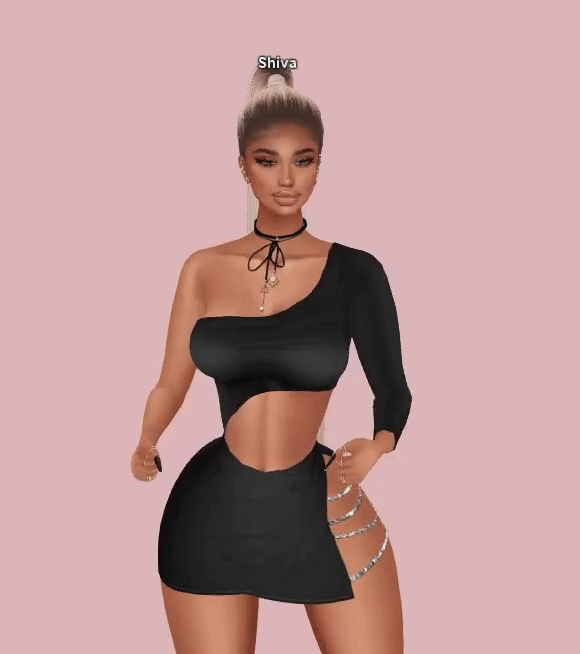
Games
I can’t really remember playing games, other than the classic Daily Spin where you could earn a few credits here and there, but while researching old IMVU stuff, I came across this screenshot which seems to be around that time. Maybe these were games where you could earn credits by completing challenges or offers, I have no idea.
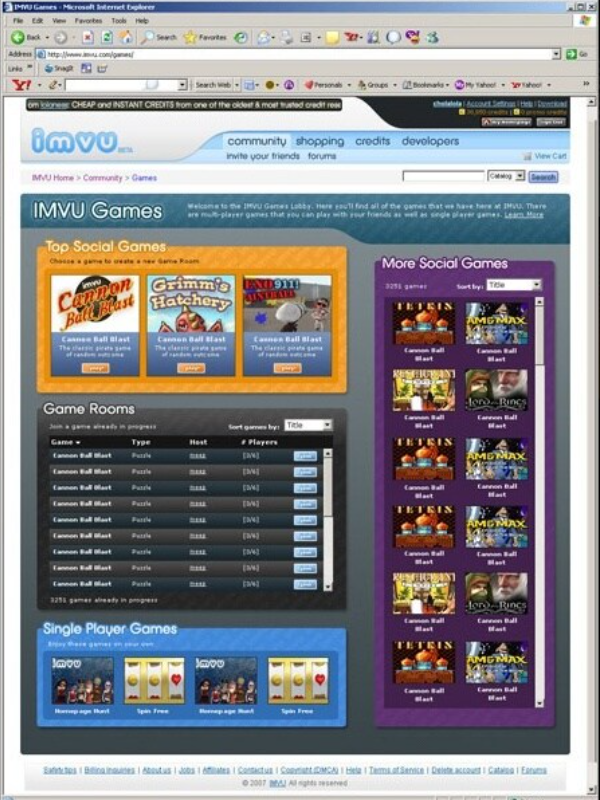
Daily Outfit Challenge
While this didn’t happen back in 2006, the Daily Outfit Challenge was a daily contest that started somewhere in 2008. Themes would be published in advance for users to have time to prepare, then they would take screenshots of their avatars and submit their entries.
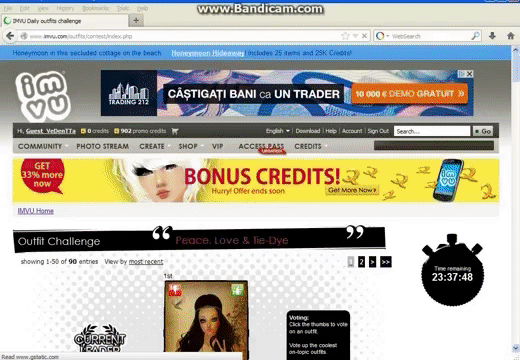
It’s worth mentioning because people loved it and it was an important step for creators to up their game. Why? The Daily Outfit Challenge was extremely popular and the first places would bring hundreds and sometimes thousands of sales for items in the outfits of the winning entries.
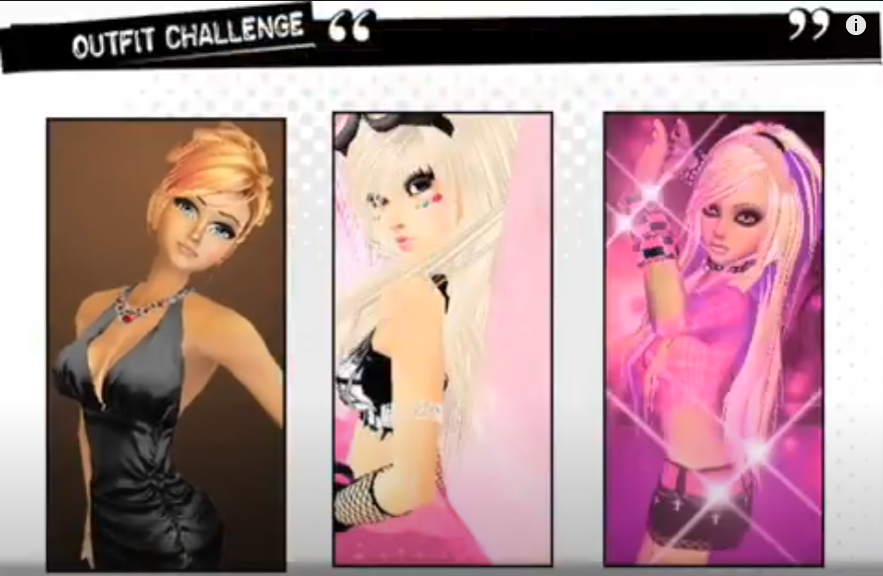
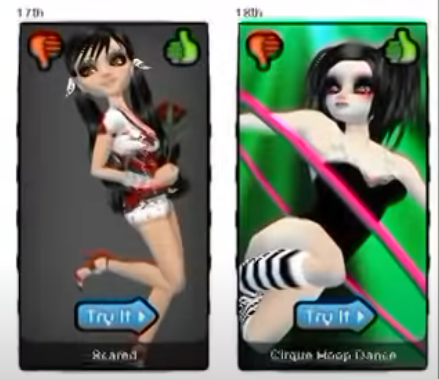
The Daily Outfit Challenge gave birth to a photo feed type of system that later transformed into the feed we have on IMVU Next.
Fun facts
- This is how IMVU used to look like in its beta phase!
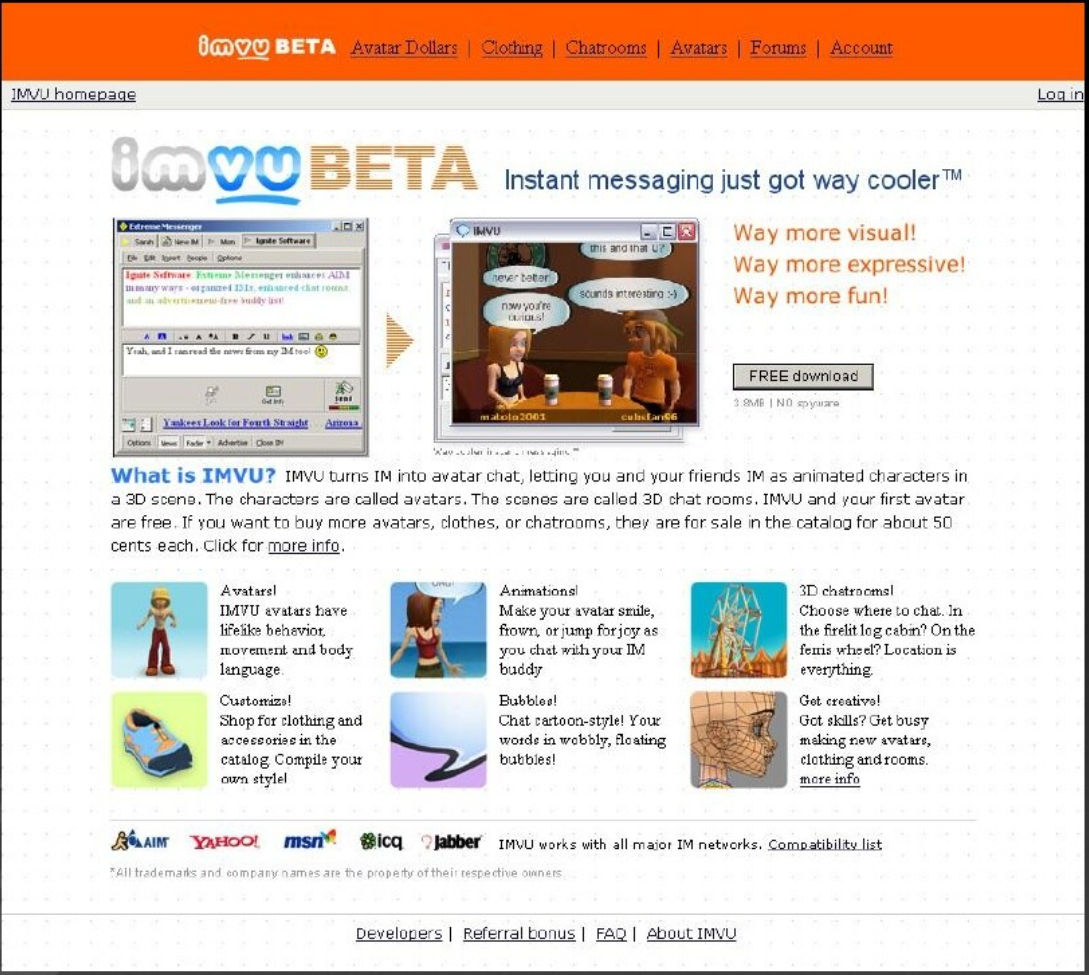
2. If you check your gallery, there are high chances that at least one of the albums still has your old name (or one of your old names) in the album title!
3. If you’re frustrated about all the categories in the shop when either browsing through products or creating and choosing the right category, remember it was developers (creators) that used to make them! The extreme variety and special characters before alphabet characters comes from the fact that developers wanted their categories to show first when people were browsing the catalog (shop). It was also very common for each hairstyle to have its own category. While nowadays it sounds insane, back in the day it was possible due to lack of variety.
4. Mayu22 was the original creator who made the basic .PSD files for skins. 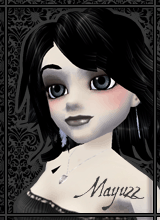
She created and named the tones which are still in use today. The file was available on her website immortal-doll.com (now obsolete). When she closed down her website and her files were still being shared on the forums, Mayu22 shared her thoughts on users and IMVU who gave away her files without her consent. Almost all existing skin tones in the shop are a derivation of Mayu22’s base, as creators would constantly enhance existing textures and not create everything from scratch (working just with the skin UV maps).
We owe Mayu22 a big round of applause! To her and everyone else who made IMVU what it is today. Thank you! ♥





